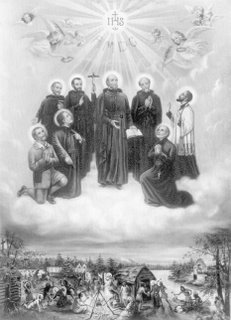 (First Sunday of Advent (B): This homily was given on November 27, 2005 at St. Pius X Church, Westerly, R.I. Read Mark 13.)
(First Sunday of Advent (B): This homily was given on November 27, 2005 at St. Pius X Church, Westerly, R.I. Read Mark 13.)[For the audio version of this homily, click here: First Sunday of Advent 2005]
The Five Man Electrical Band said it well in a song they released back in 1971—a song that went to number 3 on the Billboard Charts: “Sign, sign, everywhere a sign.”
In today’s Gospel reading from Mark 13, Jesus talks about his second coming at the end of time. He tells his disciples (and that includes all of us) to watch and to stay alert, because the exact moment of this event is hidden from our eyes. Jesus says, “You do not know when the lord of the house is coming, whether in the evening, or at midnight, or at cockcrow, or in the morning.”
But earlier in chapter 13 he makes it clear that, even though we can’t know when it will come, we can expect to see some visible signs that the end is near: earthquakes, wars, famines—and even religious deceptions.
This means that the last month of 2004 and the first 11 months of 2005 should probably be referred to as “The Year of the Sign”.
Consider some of the events of the last 12 months: a tsunami that devastated much of Southeast Asia; more hurricanes in one summer than we sometimes encounter over the course of an entire decade; 11 earthquakes 7.0 or greater on the Richter Scale. That’s not to mention the War in Iraq, and the many other armed conflicts that have taken place throughout the world during this time.
But to some extent, signs like these are always around, are they not? They might be more numerous during certain years and during certain periods of human history, but they’re never entirely absent. And they never will be—until the end!
In fact, you could make the very strong case that even in the quietest of times—even when there are relatively few wars and natural disasters—the signs are literally all around us.
Remember again the “prophetic” words of the Five Man Electrical Band: “Sign, sign, everywhere a sign.”
Let me give you some examples of what I mean:
Have you read the obituary section of the Westerly Sun today (everyone reads that part of the paper, right?)? If you have, you should understand what I’m talking about, because every obituary—every death notice—is a sign!
Every hair that falls out of your scalp is a sign.
Every lost job is a sign.
Every sickness is a sign.
Every broken relationship is a sign.
Graduating from high school is a sign.
Retirement is a sign.
A child who gets married or moves away from home is a sign.
In a remote sense, all these things are signs to us that Jesus is coming again at the end of time, because they are signs that this life is fragile and only temporary!
Last week I received a personal sign of how fragile this present life is when I was on vacation in Florida with Fr. John Sistare and Fr. Chris Mahar. Most of you know Fr. John—he’s from St. Pius, and is now the assistant pastor at St. Joan of Arc in Cumberland; Fr. Chris is the assistant at Our Lady of Mercy in East Greenwich.
On Friday, Fr. Chris received a phone call about one of his parishioners: a man who went to Mass at Our Lady of Mercy every morning. He was in his early 70s, and had come home from work on Thursday feeling rather ill. He told his wife he wanted to lay down. So he proceeded to recline on the couch, and to rest the back of his head on her lap.
Together, as was their custom, they prayed the Rosary.
When they finished, he died.
It was that quick. It was that sudden.
Jesus said, “You do not know when the lord of the house is coming.”
As I’ve already noted, that statement applies to the end of the world, when Jesus will come again in glory to judge the living and the dead. But if we don’t happen to survive on earth until that day (and at least some of us probably won’t), then those words of our Lord will apply to us at the moment of our physical death. For us, that will be our personal experience of the “second coming” of Christ.
We cannot judge anyone, of course; that is for God alone to do. But I will say this: from all external indications, at least, it appears that Fr. Chris’ parishioner was ready for that second coming of the Lord in his life. He was a daily communicant; he had a devotion to our Lady; he took his spiritual life seriously.
Thanks be to God!
Some of the young people in our Confirmation classes have been wondering why we’ve been so tough with them about getting to Mass on Sundays and holydays, and why we consistently challenge them about getting to Confession pronto whenever they need to.
To them I say, “It’s because you do not know when your Lord is coming! And we love you. We care about you, and we want you to be ready for that moment whenever it arrives.”
The Five Man Electrical Band ended the refrain of their 1971 hit with the simple question, “Can’t you read the sign?”
Well for all of us, young and not-so-young, the decisive question isn’t “Can’t you read the sign?” it’s “WILL you read the signs? WILL you CHOOSE to read them?”
The signs, you see, are everywhere; they’re literally all around us. They’re part of the fabric of life. We all can read them; we all have that innate ability. The real challenge is to make the choice to read them, and to reject the choice that many people make to ignore them completely.
May this Advent be a time for us to read the signs God is giving us, and to respond to those signs as the Lord wants us to: by giving our hearts more completely to Jesus, by being faithful to Mass, by receiving the Eucharist worthily, by getting to Confession, and by reaching out to those in need with the love of Christ.
And may God give us the grace to choose to do those things even after Advent is over—until the day that Jesus comes for us.




